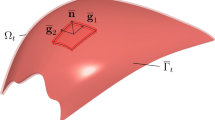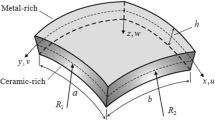Abstract
The paper describes how the Moiré reflective technique can be used to determine transverse-bending moments in a cylindrical shell. A cylindrical screen is used and the pattern of lines on it is reflected in the shell which acts as a lens and reduces the apparent pitch.
When a photograph of the unloaded shell is considered, the lines on the negative are found to vary only slightly in width so that within the limits of movement of the ray reflected from the shell the pitch can be considered uniform.
Loading the shell alters its radius and this alters the pitch of the lines as they appear on the photographic plate. It is shown that this change in line width does not affect the fringe pattern. Since the length of the reflected ray increases at distances away from the center of the photograph, a correction has to be applied to fringes at these points to obtain the correct change of slope.
Photographs of the fringe pattern are obtained for various angular positions round the shell and, from these photographs, graphs of fringe against position round the shell are plotted. After correction, the slope of these graphs allows the bending moment at a point to be calculated. It is noted that transverse and radial deflections can influence the fringe pattern and this is allowed for.
By taking photographs of the unloaded shell and measuring the widths of lines on the negative, the radius of the shell can be calculated and compared with spherometer readings. Knowing the bending moment at a point, the change in radius is calculated and the calculated final radius compared with that obtained from measurements on the separate photograph of the loaded shell.
Finally, the deflections on the transverse center line are calculated from the fringe patterns and compared with deflection-gage readings.
Similar content being viewed by others
Abbreviations
- h :
-
distance from lens to screen
- f :
-
distance from lens to photographic plate
- k ϕ1 :
-
coefficient from Table 1 for given value of ϕ andn=1
- M 1 :
-
longitudinal moment in shell per unit width
- M 2 :
-
transverse moment in shell per unit length
- n :
-
movement of reflected ray in terms of pitch of lines of lines on screen
- R :
-
radius of screen
- r :
-
radius of shell
- T 2 :
-
force applied tangentially at edge at mid-span
- y :
-
transverse distance on photographic plate
- α:
-
half the angle subtended at the lens in a longitudinal direction by a longitudinal line on shell
- δrδt :
-
deflections of shell in radial and transverse directions
- θ′:
-
angle subtended at center of shell between axis of camera and line to point on shell
- θ:
-
angle subtended at center of shell between point on shell and point on screen to which initial ray is reflected
- ϕ′:
-
angle subtended at lens between camera axis and point on shell
- ϕ:
-
angle subtended at screen surface between normal to surface and reflected ray
References
De Josselin de Jong. G., Proc. of Symp. on Shell Research. Delft. (1961).
Hazell, C. R., Internal Report. Pennsylvania State University. June (1965).
Author information
Authors and Affiliations
Rights and permissions
About this article
Cite this article
Osgerby, C. Application of the moiré method for use with cylindrical surfaces. Experimental Mechanics 7, 313–320 (1967). https://doi.org/10.1007/BF02327138
Issue Date:
DOI: https://doi.org/10.1007/BF02327138




